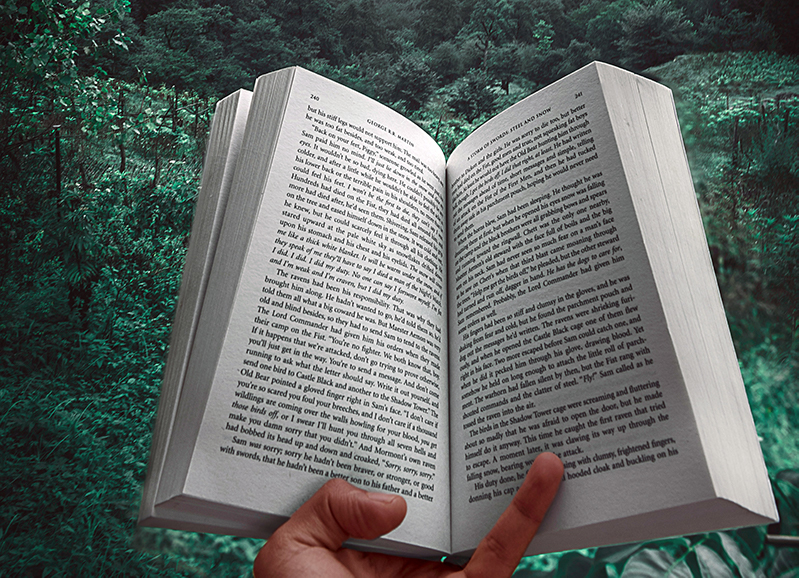Bring the Outside Inside [Outdoor Books]
Stuck inside? Stay connected with outdoor-themed books. These reads are perfect for the back porch or snuggling under a blanket by a window.
Follow us and join the conversation on Instagram and Facebook to see what other people are recommending.
This week we’re sharing some outdoor-themed classics such as Endurance, A Walk in the Woods, Into Thin Air, The Monkey Wrench Gang, The Hidden Life of Trees, plus a lot more.
- A Blistered Kind of Love by Angela Ballard: They’re not sure which came first — falling in love with each other or falling in love with the idea of hiking the Pacific Crest Trail. At the trailhead, the young couple was warned that there would be tears, that each would have to find their own separate pace, and that at times the tent would seem awfully small for the two of them. They were told that their biggest obstacles to success would be … each other.
- A Sand County Almanac by Aldo Leopold: Combines some of the finest nature writing since Thoreau with an outspoken and highly ethical regard for America’s relationship to the land. As the forerunner to such important books as Annie Dillard’s Pilgrim at Tinker Creek, Edward Abbey’s Desert Solitaire, and Robert Finch’s The Primal Place, this classic work remains as relevant today as it was nearly 70 years ago.
- A River Runs Through It by Norman Maclean: The book’s two novellas and short story are set in the small towns and mountains of western Montana. It is a world populated with drunks, loggers, card sharks, and whores, but also one rich in the pleasures of fly-fishing, logging, cribbage, and family. By turns raunchy and elegiac, these superb tales express, in Maclean’s own words, “a little of the love I have for the earth as it goes by.”
- A Walk in the Woods by Bill Bryson: More than just a laugh-out-loud hike, Bryson’s acute eye is a wise witness to the trail, and he tells its fascinating history, and makes a moving plea for the conservation of America’s last great wilderness. (There’s also a movie adaptation; you might even recognize McAfee Knob in the movie promo.)
- Be Brave Be Strong by Jill Homer: A newspaper editor in Alaska has an outlandish ambition: A 2,740-mile mountain bike race from Canada to Mexico along the rugged Continental Divide. But in the tradition of best-laid plans, her dream starts to unravel the minute it is motion.
- Bear in the Back Seat by Carolyn Jourdan: This is the first volume in a series of true stories from an “extraordinary landscape populated with befuddled bears, hormonally-crazed elk, homicidal wild boars, hopelessly timid wolves, and nine million tourists, some of whom are clueless”
- Born to Run by Christopher McDougall: An epic adventure that began with one simple question: Why does my foot hurt? Isolated by Mexico’s deadly Copper Canyons, the blissful Tarahumara Indians have honed the ability to run hundreds of miles without rest or injury. In a riveting narrative, award-winning journalist and often-injured runner McDougall sets out to discover their secrets.
- Desert Solitaire by Edward Abbey: Often compared to Henry David Thoreau’s Walden, Desert Solitaire is a powerful discussion of life’s mysteries set against the stirring backdrop of the American southwestern wilderness.
- Eat and Run by Scott Jurek: Elite athlete and vegan Jurek writes about his childhood hunting, fishing, and cooking for his meat-and-potatoes family, to his early beginnings in running (he hated it), to his slow transition to ultrarunning and veganism, to his world-spanning, record-breaking races.
- Endurance: Shackleton’s Incredible Voyage by Alfred Lansing: In 1914, polar explorer Ernest Shackleton boarded the Endurance which became locked in an island of ice. The book details the legendary ordeal of Shackleton and his crew of 27 men.
- Follow the River by James Alexander Thom: Mary Ingles was happily married and pregnant with her third child when she was kidnapped in 1755. But nothing could imprison her spirit. With the Ohio River as her guide, Ingles walked 1,000 miles through an untamed wilderness.
- Folks, This Ain’t Normal: A Farmer’s Advice for Happier Hens, Healthier People, and a Better World by Joel Salatin: From farmer Salatin’s point of view, life in the 21st century just ain’t normal. Here, he discusses how far removed we are from the simple, sustainable joy that comes from living close to the land and the people we love. Salatin has many thoughts on what normal is and shares practical and philosophical ideas for changing our lives in small ways that have big impacts.
- Into Thin Air by Jon Krakauer: On assignment for Outside magazine, Krakauer went to the Himalayas to report on the growing commercialization of the planet’s highest mountain and witnessed the deadliest season in the history of Everest.
- Let My People go Surfing by Yvon Chouinard: In his long-awaited memoir, Chouinard – a legendary climber, businessman, environmentalist, and founder of Patagonia – shares the persistence and courage that have gone into being head of one of the most respected and environmentally responsible companies on earth.
- My Side of the Mountain by Jean Craighead: Sam Gribley is terribly unhappy living in New York City, so he runs away to the Catskill Mountains to live in the woods. With only a penknife, a ball of cord, 40 dollars, and some flint and steel, he intends to survive on his own. Gribley learns about courage, danger, and independence during his year in the wilderness, a year that changes his life forever.
- No Shortcuts to the Top by Ed Viesturs: This gripping and triumphant memoir follows a living legend of extreme mountaineering as he makes his assault on history, one 8,000-meter summit at a time.
- Omnivore’s Dilemma by Michael Pollan: A society of voracious and increasingly confused omnivores, we are just beginning to recognize the profound consequences of the simplest everyday food choices, both for ourselves and for the natural world. The Omnivore’s Dilemma become known for bringing a completely fresh perspective to a question as ordinary and yet momentous as “What shall we have for dinner?”
- Sea of Slaughter by Farley Mowatt: When it was first published nearly 30 years ago, Sea of Slaughter served as a catalyst for environmental reform, raising awareness of the decline and destruction of marine and coastal species. It remains a chilling environmental classic, serving as a haunting reminder of the impact of human interest on the natural world.
- Silent Spring by Rachel Carson: First published in 1962, Silent Spring can be credited with sounding the alarm and raising awareness of humankind’s collective impact on its own future through chemical pollution. No other book has so strongly influenced the environmental conscience of Americans and the world at large.
- The Control of Nature by John McPhee: Looks at three examples of people battling nature to achieve (or fail to achieve) their own desires.
- The Earth is Enough by Harry Middleton: It is the year 1965 and 12-year-old Harry is turned over to two enigmatic guardians, men as old as the hills they farm and as elusive and beautiful as the trout they fish for—with religious devotion. Seeking strength and purpose from life, Harry learns from his uncle, grandfather, and their crazy neighbor.
- The Emerald Mile by Scott Jurek: From one of Outside magazine’s “Literary All-Stars” comes the thrilling true tale of the fastest boat ride ever, down the entire length of the Colorado River and through the Grand Canyon, during the legendary flood of 1983.
- The Hidden Life of Trees by Peter Wohlleben: How do trees live? Do they feel pain or have awareness of their surroundings? Research is suggesting trees are capable of much more than we have ever known, and Wohlleben puts groundbreaking scientific discoveries into a language everyone can relate to.
- The Monkey Wrench Gang by Edward Abbey: George Hayduke returned from war to find his beloved southwestern desert threatened by industrial development. Joining with a feminist saboteur, wilderness guide and outcast, and a libertarian billboard torcher, Hayduke is ready to fight, taking on strip miners, clear-cutters, and the highway, dam, and bridge builders who are threatening the natural habitat.
- The Old Man and the Boy by Robert Ruark: This classic captures the endearing relationship between a man and his grandson as they fish and hunt the lakes and woods of North Carolina. All the while the Old Man acts as teacher and guide, passing on his wisdom and life experiences to the boy, who listens in rapt fascination.
- The Overstory by Richard Powers: The novel is about nine Americans whose unique life experiences with trees bring them together to address the destruction of forests.
- The River Why by David James Duncan: Gus Orviston is a young fly fisherman who leaves behind his comically schizoid family to find his own path. Taking refuge in a remote cabin, he sets out in pursuit of the Pacific Northwest’s elusive steelhead. But what begins as a physical quarry becomes a spiritual one as his quest for self-knowledge batters him with unforeseeable experiences.
- The Sun is a Compass by Caroline Van Hemert: In 2012, the Van Hemerts set off on a 4,000-mile wilderness journey from the Pacific rain forest to the Alaskan Arctic, traveling by rowboat, ski, foot, raft, and canoe. They survived harrowing dangers while also experiencing incredible moments of joy and grace.
- The Unlikely Thru-Hiker by Derick Lugo: Join Derick, a young black man from the city, unfamiliar with the outdoors and thru-hiking culture, as he sets off with an extremely overweight pack and a willfully can-do attitude to conquer the infamous Appalachian Trail.
- Ultimate High by Goran Kropp: A personal account of one man’s determination to climb Mount Everest alone describes how the Swedish climber accomplished his goal, within days of the 1995 tragedy that took the lives of fellow climbers.
- Walden: Life in the Woods by Henry David Thoreau: Walden details Thoreau’s life for two years in second-growth forest around the shores of Walden Pond. It’s a reflection upon simple living in natural surroundings.
- Watership Down by Richard Adams: Fiver could sense danger. Something terrible was going to happen to the warren; he felt sure of it. They had to leave immediately. So begins a long and perilous journey of survival for a small band of rabbits. An epic journey, a stirring tale of adventure, courage, and survival.
- Wilderness and the American Mind by Roderick Nash: Classic study of America’s changing attitudes toward wilderness has received wide acclaim since its initial publication in 1967. The Los Angeles Times has listed it among the 100 most influential books published in the last quarter century, Outside included it in a survey of “books that changed our world,” and it has been called the “Book of Genesis for environmentalists.”




 Powered by Roanoke Outside
Powered by Roanoke Outside